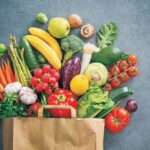Sheryl Salis explains the importance of understanding food labels
When you go grocery shopping, if you check, just about every packaged food available today has a food label indicating serving size and other nutritional information. The “Nutrition Facts” food labels are intended to give you information about the specific packaged food in question. Measurements of fat, cholesterol, sodium, carbohydrate, protein, vitamins, and minerals are calculated for a “typical portion”. It is important that every time you are at the grocery store take out that extra minute to look at the food labels of the items you’re buying. Reading the label is the only way to know what you’re eating.
Below are some explanations of its components.
Serving size
It is important that you pay attention to the serving size, especially the number of servings in the package and compare it to how much you actually eat. The size of the serving on the food package influences all the nutrient amounts listed on the top part of the label. For example, if a packet has 4 servings and you eat half the packet, it means you have eaten two servings. You double the calories, fat, etc. that you have eaten.
Calories
Calories provide a measure of how much energy you get for the stated serving size. The number of servings you consume determines the number of
servings in the package and compare it to how much you actually eat. The size of the serving on the food package influences all the nutrient amounts listed on the top part of the label. For example, if a packet has 4 servings and you eat half the packet, it means you have eaten two servings. You double the calories, fat, etc. that you have eaten.
Calories
Calories provide a measure of how much energy you get for the stated serving size. The number of servings you consume determines the number of calories you actually eat (your portion amount). If a packet has 2 servings of 250 calories each and you ate the entire packet that means you consumed two servings, or
500 calories.
Nutrients
It is recommended that you keep your intake of saturated fat, trans fat sodium and simple sugars to as low as possible as part of a nutritionally balanced diet. Eating too much fat, saturated fat, trans fat, sugars or sodium may increase your risk of certain chronic diseases, like heart disease, increase your “bad” LDL cholesterol and decrease your “good” HDL cholesterol, some cancers, high blood pressure, along with stroke and Diabetes. To reduce your intake of trans fat to less than 1%, you shouldn’t consume more than 20 calories in trans-fat, or less than 2 g of trans fat in a day. Get enough of these:
- Dietary fibre
- Vitamin A
- Vitamin C
- Calcium
- Iron
Most of us do not get enough protein, dietary fibre , vitamins A and C, calcium, and iron in our diets. Eating enough of these nutrients can improve your health and help reduce the risk of some diseases and conditions.
Carbohydrate Count
Total carbohydrates
This is the amount of carbohydrates per serving. To determine the serving size, check the label for the number of carbohydrate grams (g). If in a food label the total carbohydrate mentioned is 10 grams, then check the top of the food label for the serving size for one serving. This means that for a serving size of 1 cup the total carb intake is 10 grams.
Beneath the Total Carbohydrates line in this section there will be two or three other lines mentioning fibre, sugars, and sometimes sugar alcohols.
Sugar
Sugar is included in the total carbohydrate amount. It is important to keep checks on the amount of carbs coming from sugar. This number must be as low as possible. Compare different brands and products and choose the ones with the lowest number of sugar grams per serving.
Fibre
Fibre is one type of carbohydrate that does
not raise blood glucose. In fact, the presence of fibre can slow down the impact of the other carbohydrates in a meal.
Therefore, when counting carbs, if a food has fibre, you can subtract the fibre grams from the total grams of carbohydrate to get a more accurate estimate of the carbohydrate impact on your diet. This gives a number which is called effective carbs or net carbs for example, if a cereal has 23 grams of carbohydrate per serving, but also 5 grams of fibre. You could consider it to be only 18 grams of carbohydrate.
Sugar alcohol
Sugar alcohols are like sugar but they are not completely absorbed by the body.
Hence, the blood sugar impact of sugar alcohols is less and they provide fewer calories per gram. Look for the names of the individual sugar alcohols on the ingredient list of any product that contains them. If the product is labelled “sugar-free” or “no added sugar, the product may contain sugar alcohol .They will be included in the amount of carbohydrate on the label, either in the total or on a separate line for sugar alcohols.
Many sugar alcohols can cause flatulence (gas), bloating and other abdominal problems because they are not completely digested.
Understanding Daily Value (DV)
% Daily Value is always mentioned on the foot note on the label and shows how a food fits into a 2,000 to 2500 calorie/day diet. For diets other than 2,000 calories, divide by 2,000 to determine the % Daily Value for nutrients. For example, if you are following a 1,500-calorie diet, your % Daily Value goal will be based on 75% for each nutrient, not 100%.
For fat, saturated fat and cholesterol and sodium, choose foods with a low % Daily Value. For total carbohydrates, protein, dietary fibre, vitamins and minerals, try to at least reach your goal for each nutrient.
Ingredients
Each product should list the ingredients on the label. They are listed from largest to smallest amount (by weight). This means a food contains the largest amount of the first ingredient and the smallest amount of the last ingredient. It may also have a mention of the presence of common allergens like soy, peanuts, wheat (gluten) and milk (lactose)
Label claims
Another aspect of food labelling is label claims. Some food labels make claims such as “low cholesterol” or “low fat.” These claims can only be used if a food meets strict government definitions. Here are some of the meanings:
- Calories– 40 Calories/100 g or 20 calories/100 ml is low
- Sugar Content-6 g of sucrose/sugar or 1 teaspoon /portion
- Calorie Free- must be less than 4 calories/
100 ml
- Low fat– not more than
3 g of fat/100 g for solids or 1.5 g fat/100 ml of liquids (1.8 g of fat/ 100 ml of semi skimmed milk)
- Fat Free- not more than 0.5 g fat/100 g or 100 ml
- Low saturated fat not more than 75 g/100 ml for liquids and 1.5g per 100 g for solids
- Low sugars- not more than 5 g of sugars per 100 g for solids and 2.5 g of sugars per 100 ml for liquids
- Sugar Free- not more than 0.5 g of sugars/100 g or 100 ml
- Low sodium /salt- not more than 12 g sodium /100 g or 100 ml
- Sodium free or Salt free- not more than 0.005 g of sodium per 100 g
- Source of fibre- product must contain at least 3 g fibre per 100 g or 1.5 g fibre per 100 cals
- High fibre- product must contain at least 6 g fibre per 100 g or 3 g fibre per 100 cals
- Source of protein-at least 10 per cent of energy value coming from protein
- High protein at least 20 per cent of energy value coming from protein
Ms Sheryl Salis is a Registered Dietician, Certified Diabetes Educator and Certified Pump Trainer with more than 20 years of experience in the field of Nutrition and Diabetes Education. She is the Founder of Nurture Health Solutions.













